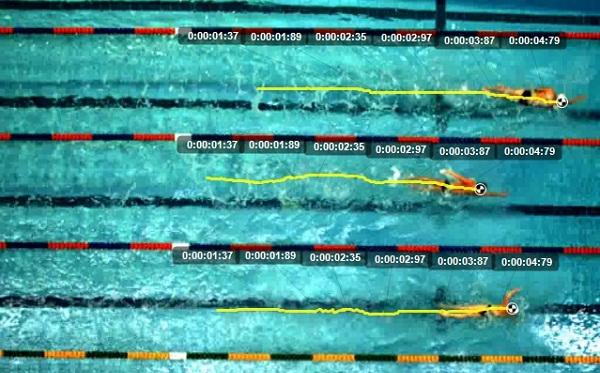
A screen shot from one of the overhead IP cameras at the Sydney Aquatic Centre showing swimmer's strokes and times. This data will be used to help NSW Institute of Sports swim teams prepare for the 2016 Olympic Games in Brazil.
A swimmer takes to the pool in Sydney’s Aquatic Centre. As he or she glides through the water, four IP cameras installed in the roof capture body movements and times — vital information when preparing for the Olympic Games where even a split second can mean the difference between winning gold or silver.
NSW Institute of Sport ICT manager Greg Baxter told Computerworld Australia that the cameras help coaches analyse swimmers' strokes and also reveal if a swimmer can keep a straight line in the pool.
Data generated from the overhead IP cameras is stored within the Institute’s network on a work station.
Future Olympic Australian swimmers get 3D imaging performance boost
Cricket Australia sends technology in to bat
Holograms may appear at future Olympics:Report
“Our coaches are very pleased with the results they are getting and quite surprised at the lateral movements that swimmers can show in training, even after the coaches have told them to swim as straight as they can,” Baxter said.
Coaches also have access to data from underwater cameras at the Aquatic Centre giving them a complete picture of how their swimmers are performing.
“We’re always looking at new technologies to give our athletes the edge,” he said. “That’s critical for elite sports these days.”
The IP camera data will be used to help the Institute’s future Olympic swimmers prepare for the 2016 Olympic Games in Rio de Janeiro, Brazil, where it is hoped Australia will dominate in the pool.
In addition to helping its Olympic swimmers, the Institute has installed two IP cameras for the water polo team to help with performance analysis.
“In water polo, the coach focuses on the goal areas so we want a still camera but also another IP camera to zoom out of the goal area in case the coach needs to see other angles,” Baxter said.
The Institute also has plans to install two IP cameras for its divers. One of the cameras will be focused on the 10-metre diving tower and another on the three-metre dive boards.
“Currently, the dive squad has an older system set up where they film the dive using delayed timing so the diver can do her or his dive, swim across to the side of the pool and view the replay on a plasma screen,” he explained.
Dark fibre and security
Away from the pool, Institute staff and athletes make use of the Sydney Olympic Park Authority’s (SOPA) dark fibre network which was rolled out for the 2000 Olympic Games.
The Institute has its head office in Victory Drive by the Olympic Stadium. Fibre connections are run throughout the park to the Institute’s Aquatic Centre, Hockey Centre, Athletic Centre and the State Sport Centre.
According to Baxter, the dark fibre network is predominately single node fibres so staff can experience speeds of up to 1GB.
While he added that the speeds are adequate for use by coaches and athletes, SOPA is in the process of upgrading the dark fibre network to multi-mode fibre.
“From our building we’ve got both connections running to a common point so once SOPA finishes the upgrade, we can make better use of that faster connection,” Baxter said.
Because the Institute’s network is accessed by a multitude of people, two Dell SonicWall firewalls are run to keep the 'bad guys' out of the network.
Baxter receives a report of any suspicious activity from the firewalls every day.
“I also run wireless access protocol [WAP] connections across all of our sites,” he said. “It’s quite handy for our dive or water polo coaches because if they get to the pool early they can jump on the computers, check their emails, browse the Web and upload training videos.”
He added that the Institute has worked with SonicWall, which was acquired by Dell in March 2012, for the past five years.
“As the Institute has grown and our data has grown, I’ve upgraded our firewalls,” he said. After all, athletes and coaches need protection like the rest of us.
Follow Hamish Barwick on Twitter: @HamishBarwick
Follow Computerworld Australia on Twitter: @ComputerworldAU, or take part in the Computerworld conversation on LinkedIn: Computerworld Australia
Join the CIO Australia group on LinkedIn. The group is open to CIOs, IT Directors, COOs, CTOs and senior IT managers.
